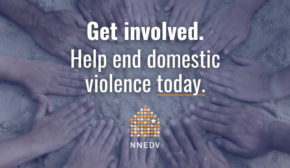Frequently Asked Questions about Domestic Violence
- What is domestic violence?
- What resources are available for victims?
- Why do victims sometimes return to or stay with abusers?
- Do abusers show any potential warning signs?
- Is it possible for abusers to change?
- Are men victims of domestic violence?
- How does the economy affect domestic violence?
- What can I do to help?
1. What is domestic violence?
Domestic violence is a pattern of coercive, controlling behavior that can include physical abuse, emotional or psychological abuse, sexual abuse or financial abuse (using money and financial tools to exert control). Some abusers are able to exert complete control over a victim’s every action without ever using violence or only using subtle threats of violence. All types of abuse are devastating to victims.
Domestic violence is a pervasive, life-threatening crime that affects millions of individuals across the United States. High-profile cases of domestic violence will attract headlines, but thousands of people experience domestic abuse every day, and they come from all walks of life.
In our annual Domestic Violence Counts Report, the National Network to End Domestic Violence (NNEDV) finds that U.S. domestic violence shelters and programs serve thousands of victims and answer thousands of crisis hotline calls, chats, texts, and emails every day of the year.
Abusive partners make it very difficult for victims to escape relationships. Sadly, many survivors suffer from abuse for decades. It is important for survivors to know that the abuse is not their fault, and that they are not alone. Help is available to those who are experiencing domestic violence..
2. What resources are available for victims?
Survivors have many options, from obtaining a protection order, staying in a shelter, exploring options through support groups, or making an anonymous call to a local domestic violence shelter or national hotline. There is hope for victims, and they are not alone.
There are hundreds of local shelters across the United States that provide safety, counseling, legal help, and other resources for victims and their children.
Information and support are available for victims of abuse and their friends and family:
Hotlines
- If you are in immediate danger and feel comfortable involving law enforcement, please call 911.
- The U.S. National Domestic Violence Hotline provides confidential and anonymous support 24/7. Reach out by phone (1-800-799-7233), TTY (1-800-787-3224), chat (TheHotline.org), or text (START to 88788).
- Loveisrespect provides teens and young adults confidential and anonymous support. Reach out by phone 1-866-331-9474 and TTY 1-866-331-8453.
- WomensLaw.org (a project of NNEDV) provides legal information and resources for victims. Reach out by email through the WomensLaw Email Hotline in English and Spanish.
Information
- Technology can be used by victims to increase safety and privacy; it can also be misused by perpetrators to harass, abuse, or harm victims. Find information, including resources and toolkits, related to technology safety at TechSafety.org.
- Financial abuse is widespread. Learn more about rebuilding from financial abuse from The Moving Ahead Curriculum.
- Find state- and territory-specific legal information on WomensLaw.org related to custody, protection orders, divorce, and more.
TIP: Before using online resources, know that your computer or phone may not be safe. Some abusive partners misuse technology to stalk and track a partner’s activities on a computer, tablet, or mobile device. (Learn more at TechSafety.org.)
3. Why do victims sometimes return to or stay with abusers?
The question is not “Why doesn’t the victim just leave?” The better question is “Why does the abuser choose to abuse?”
The deck is stacked against victims as they navigate safety:
Abusive partners work very hard to keep victims trapped in the relationship. They may try to isolate the victim from friends and family, thereby reducing the people and places where the survivor can go for support.
Through various tactics of financial abuse, abusive partners create financial barriers to safety.
There is a real fear of death or more abuse if they leave, as abusers may perceive this act of independence as a threat to the power and control they’ve worked to gain, and they may choose to escalate the violence in response.
Through “gaslighting,” abusive partners cause victims to feel like they are responsible for the abuse. Gaslighting is a form of emotional abuse that abusers use to confuse and shift blame onto the victim. This often causes the victim to doubt their sanity and feel like they are responsible for the abuse and, therefore, able to stop it.
Abuse takes an emotional and physical toll over time, which can translate to additional health issues that make leaving more difficult.
Survivors often report that they want the abuse to end, not the relationship. A survivor may stay with or return to an abusive partner because they believe the abuser’s promises to change.
4. Do abusers show any potential warning signs?
There is no way to spot an abuser in a crowd, but most abusers share some common characteristics. Some of the subtle warning signs include:
- They insist on moving quickly into a relationship.
- They can be very charming and may seem “too good to be true.”
- They insist that you stop participating in your preferred leisure activities or spending time with family and friends.
- They are extremely jealous or controlling.
- They do not take responsibility for their actions and blame others for everything that goes wrong.
- They criticize their partner’s appearance and make frequent put-downs.
- Their words and actions don’t match.
It’s important to remember that domestic violence is first and foremost a pattern of power and control. Any one of these behaviors may not be indicative of abuse on its own, until it is considered as part of a pattern of behavior.
5. Is it possible for abusers to change?
Yes, but they must first make the choice to change their behavior. It’s not easy for an abusive partner to stop choosing abusive behavior, and it requires a serious commitment to change. Once an abuser has had all of the power in a relationship, it’s difficult to transition to a healthy relationship where each partner has equal respect and power.
Sometimes an abusive partner stops one form of the abuse – for example, the physical violence – but continues to employ other forms of abuse, such as emotional, sexual, or financial abuse. It is important to remember that domestic violence includes one or more forms of abuse and is a part of an overall pattern of seeking power and control over the victim.
6. Are men victims of domestic violence?
Yes, men can be victims of domestic abuse. Domestic violence is a pervasive, life-threatening crime that affects millions of individuals across the United States.
According to the Centers for Disease Control and Prevention, more than four in 10 men (44.2% or 52.1 million) in the United States reported contact sexual violence, physical violence, and/or stalking by an intimate partner at some point in their lifetime.
Pervasive stereotypes that men are always the abuser and women are always the victim discriminates against survivors who are men and discourages them from coming forward with their stories. Survivors of domestic violence who are men are less likely to seek help or report abuse. Many are unaware of services for men, and there is a common misconception that domestic violence programs only serve women.
When we talk about domestic violence, we’re not talking about men versus women or women versus men. We’re talking about violence versus peace and control versus respect. Domestic violence affects us all, and all of us must be part of the solution.
7. How does the economy affect domestic violence?
A bad economy does not cause domestic violence – and the only person responsible for abuse is an abuser – but economic stressors can worsen certain aspects of domestic violence. The severity and frequency of abuse can increase when factors associated with a bad economy are present. Job loss, housing foreclosures, debt, and other factors contribute to higher stress levels at home, which can lead some people to choose to channel their frustration into violent, controlling behavior against partners or other family members.
As the abuse gets worse, a weak economy also limits options for survivors to seek safety or escape. Additionally, domestic violence shelters and programs may experience funding cuts right when they need more staff and funding to keep up with the demand for their services. Victims may also have a more difficult time finding a job to become financially independent of abusers.
8. What can I do to help?
Everyone can speak out against domestic violence. Use our 10 Tips to Have an Informed Conversation about Domestic Violence to help guide your conversations with friends, colleagues, and loved ones.
Every person can take individual action to create a supportive community for survivors. Get involved in your community – we’ve got ideas for creative ways to get involved in our Get Involved Toolkit.
Members of the public can donate to local, statewide, territorial, or national anti-domestic violence programs or victim assistance programs, like NNEDV. Find your state or territory coalition here.
You can call on your public officials to support life-saving domestic violence services and hold perpetrators accountable. Learn more, or take action here.

